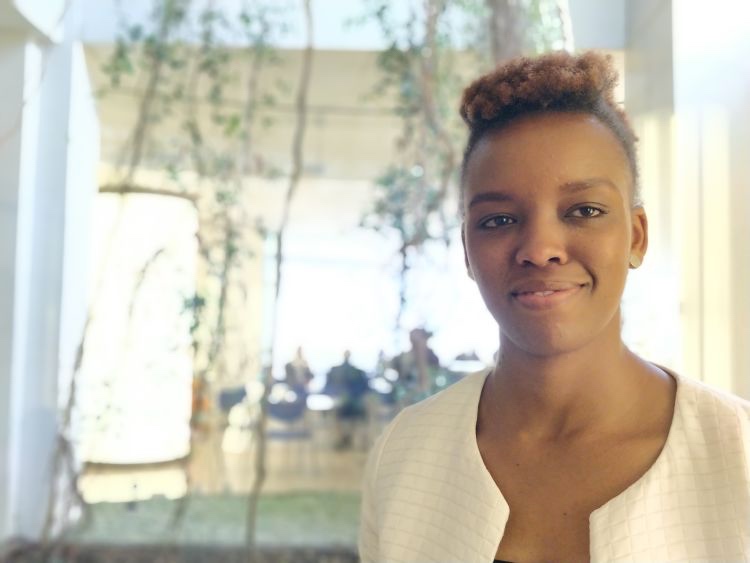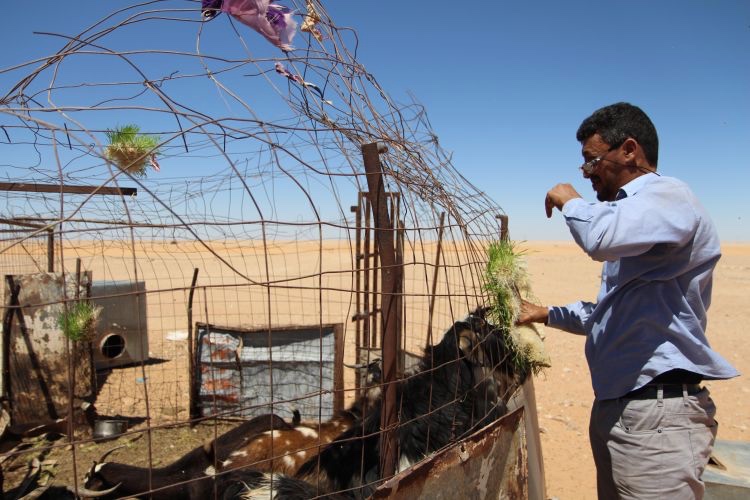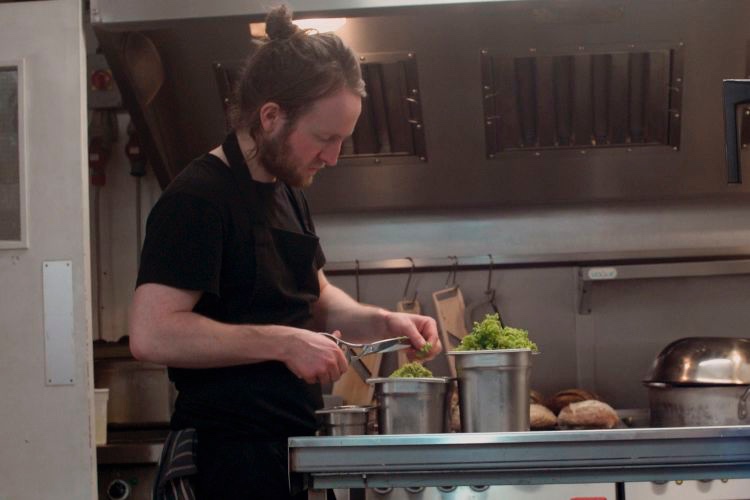
In the second part of a two part special on the future of food (head here for part one), THIN LEI WIN, of the Thomson Reuters Foundation, looks at how food production is being transformed…
This is the second part of a two part special. Head here for part one.
Widening divide?
To grow enough food despite increasing water scarcity – agriculture today sucks up about 70 per cent of global freshwater used each year – farmers are also looking to technology.
By tweaking a gene found in all plants, for instance, a team of international scientists have tricked tobacco plants into partially closing their stomata, microscopic pores in the leaf that let water evaporate.

Rita Kimani, co-founder of FarmDrive, a Kenyan start-up working to provide smallholders with access to loans and financial services, at the International Fund for Agricultural Development (IFAD) in Rome, on 3rd May, 2018. PICTURE: Thin Lei Win/Thomson Reuters Foundation.
The plants grew with a quarter less water and little impact on harvests, said Steven Long, a crop sciences professor at Britain’s Lancaster University.
Researchers hope the tweak will work as well in cowpea and soybean, main sources of protein in developing countries, and in rice, a major staple food.
“It’s showing the possibility of partnerships…and that’s really how we are going to solve the challenges the farmers face. One tool or one organisation is not going to solve everything.”
– Rita Kimani, co-founder of FarmDrive
Despite the benefits of such innovations, some critics fear they could widen the divide between farmers who can access innovation and those who cannot.
Farms which rely mainly on family labour produce the bulk of food in developing countries but many cannot afford the latest agricultural technologies.
Many farmers also live in countries that lack access to reliable weather information, which can make planting and harvesting crops a risky endeavour, experts say.
Agriculture’s technological revolution, in its current form, is neither inclusive nor democratic, said Andy Jarvis, research director at the Colombia-based International Centre for Tropical Agriculture, in part because few of the innovations are aimed at small-scale farmers.
What those farmers grow is “not a monoculture of 20 hectares of lettuce production in California or Europe but half-hectare plots of maize,” he said.
But farmers do have mobile phones, so finding ways to use them to improve farming is essential, added Dr Jarvis, who co-founded the CGIAR Platform for Big Data in Agriculture.
One company bringing technology to small farmers is Hello Tractor in Nigeria, known as “Uber for tractors”.
Founded by Jehiel Oliver, a former American investment banker, it started by selling two-wheel tractors equipped with GPS antennae – but most farmers found the prices too steep.
Hello Tractor now uses mobile phones to link those able to buy tractors with farmers who want to use tractor services.
“Most farmers can’t afford to own a tractor and most tractor owners struggle to identify customers within rural, disjointed markets,” Mr Oliver said in an email.
A Kenya start-up, meanwhile, is banking on mobile phone technology to help small-scale farmers get much-needed credit from banks.
FarmDrive, founded by two Kenyan computer scientists – both women who grew up in farming families – aims to help farmers who need loans use satellite images and sensors to paint a detailed picture of their potential yields and risks.
In December, FarmDrive teamed up with Safaricom, Kenya’s biggest telecoms company that set up the revolutionary mobile money platform M-Pesa.
Now Safaricom’s DigiFarm mobile platform offers small farmers everything from discount vouchers for fertiliser to help getting small loans or training, all in one place.
Using the new platform, FarmDrive reached 10,000 farmers in four months, compared to just 5,000 farmers in two years when the company was working alone, co-founder Rita Kimani said.
“It’s showing the possibility of partnerships…and that’s really how we are going to solve the challenges the farmers face. One tool or one organisation is not going to solve everything,” she said.
Out of the box solutions
Others are coming up with more unusual solutions.
The Sahrawi refugee camps in western Algeria, near the border with Mauritania, Western Sahara and Morocco, might seem an unusual spot to try hydroponic farming, in which plants are grown in water rather than soil.
Land around the camps is arid, isolated and prone to sandstorms and extreme swings in temperature – and the 173,000 Sahrawis from Western Sahara, stuck in the camps for the past four decades, are nomads who prefer meat and milk.
But the pastoralists are now using bare-bones hydroponics units of metal and plastic to grow mats of barley as animal feed.
The plants – the only green thing visible for miles – are ready to use in just seven days, and are grown with just a tenth of the water needed for traditional crops.

Taleb Brahim feeds goats with the green fodders grown from his hydroponic units at Smara refugee camp in Tindouf, westernmost Algeria on 8th April. Thomson Reuters Foundation/Thin Lei Win
“As refugees, we are poor people and can’t afford expensive things like fertilisers and hybrid seeds,” said Taleb Brahim, one of the brains behind the project.
Nearly 2,000 kilometres east, in Ouargla in southern Algeria, date and palm farmers are similarly turning to an unusual strategy – rearing fish in the Sahara.
The switch is part of the North African nation’s push to increase fish production as catches from the Mediterranean Sea dwindle.
The project aims to help farmers not only earn cash selling fish but also boost their harvests by using nutrient-rich water from fish ponds on crops.
At the Coopedota cooperative in Costa Rica, meanwhile, sustainable techniques such as reducing chemical sprays, planting more shade trees, and cutting energy and water consumption have brought an added benefit for farmers.
“As refugees, we are poor people and can’t afford expensive things like fertilisers and hybrid seeds.”
– Taleb Brahim, one of the brains behind a hydroponic project.
Beyond cutting costs and improving efficiency, they now sell the world’s first officially certified carbon neutral coffee. Farmers hope customers will pay a premium.
“We can put our coffee in the international market and if the market is at $US120, we might get $US180 or $US200,” said grower Fernando Solis Arguedas, a third generation coffee farmer.
Waste not, want not
In developing countries about 40 per cent of food grown is spoiled or lost after harvest. Then another 40 per cent of what gets to retailers or consumers in developed countries is wasted, according to the Food and Agriculture Organization.
Cutting that waste is crucial to reducing climate change and growing demands on limited water and land, experts say. And now chefs are moving to the forefront of the effort.
In the leafy seaside town of Brighton, Silo, Britain’s first zero-waste restaurant, turns leftover whey from making cheese into sauce, bread crust into miso soup and inedible parts such as egg shells and bones into compost.
Michelin-starred chef Massimo Bottura of Italy opened a new restaurant in central London last year, the Refettorio Felix, that doesn’t welcome wealthy diners but caters for the poor with meals cooked from supermarket scraps.
In Leeds, in northern England, Adam Smith’s The Real Junk Food Project started out as a single cafe in 2013, taking food destined for landfills to local schools to support low-income families and teach pupils about food waste.
It has since ballooned into a network of more than 120 eateries and stores, including Britain’s first pay-what-you-like food waste supermarket, offering anything from zucchini to breakfast cereals.

Chef Douglas McMaster prepares food in the kitchen of Silo, a zero waste restaurant in Brighton, United Kingdom. Cormac O’Brien/Thomson Reuters Foundation.
Mr Smith says he hopes one day the network will go out of business, as food waste is reduced from field to plate.
“Ideally the measure of success…would be that we would no longer be here,” he said.
Richard Horsey, co-author of Ugly Food: Overlooked and Undercooked, thinks part of achieving that is persuading people to diversify what they cook and include things they might bin.
He lists octopus, pigs’ trotters and wild rabbit as some of the ingredients often overlooked in Anglo-Saxon food cultures.
“I really do think that if you can make a change to what people are putting on the table every evening, that’s where the numbers are, that’s where the impact is,” he said.
A more diverse diet is also is a resilient one, experts say.
“I really do think that if you can make a change to what people are putting on the table every evening, that’s where the numbers are, that’s where the impact is.”
– Richard Horsey, co-author of Ugly Food: Overlooked and Undercooked
Historically, farmers cultivated at least 7,000 plants to eat but today 60 per cent of global calories come from just three plants – wheat, rice and maize.
Helping Asia – known for its insatiable appetite for rice – eat more millet, a forgotten rural diet staple that is rich in protein and can grow in salty soil – could help keep harvests sufficient as climate change takes hold, experts say.
Buyers in Taiwan, Japan, South Korea and Hong Kong are already eating less rice, while India is pushing millets as a way to reduce a stubbornly high rate of malnutrition.
Rebooting food
Technological advances hold promise to make food systems work better. But experts warn there are no quick wins when it comes to reshaping something as fundamental as food and agriculture.
“Technologies are just a tiny part in the whole puzzle,” said Tom Anyonge, lead technical specialist for the International Fund for Agriculture Development.
Policies, institutions and food systems also need shifts if technology is to achieve its potential, he said.
He pointed to M-Pesa, which lets mobile phone users transfer or borrow money, pay bills and save via texts. Launched by Kenya’s Safaricom in 2007, it now has nearly 28 million users in a nation of 45 million and has been expanded or mimicked across Africa.
Its success is due not just to the pioneering technology but to efforts behind the scenes to make it work, Dr Anyonge said.
Those include improving mobile coverage, opening up Kenya’s telecoms sector, and enacting laws allowing partnerships between mobile companies and banks.
“It would have stayed as a good idea” if not for that help, he said. “You need to touch on so many other things beyond technology.”
The International Food Policy Research Institute‘s director-general Shenggen Fan agrees.
Innovations are key to rebooting the food system – but they should not be limited to just technological ones, he said.
“Innovation in policies, innovations in institutions, innovations in even new thinking, open-mindedness, will be important.”
– With additional reported by UMBERTO BACCHI, RINA CHANDRAN and SOPHIE HARES.





